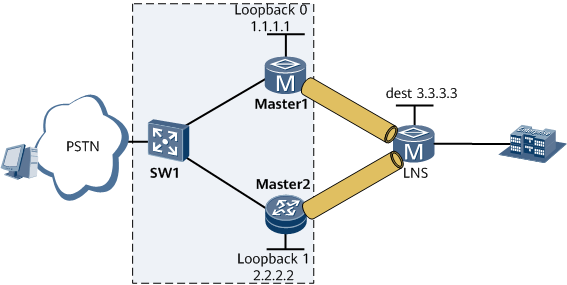Dual-Device Hot Backup on the LAC Side
Context
- The master and backup LACs use the same IP address to establish L2TP tunnels with the LNS.
- The master and backup LACs synchronize L2TP tunnel and user information with each other.
- A protection tunnel (LSP/L2TP tunnel) is set up between the master and backup LACs.

Process of Dual-Device Hot Backup
The process of dual-device hot backup is as follows:
A terminal is connected to Master 1 (master LAC) through PPPoE dialup.
Master 1 (master LAC) performs PPP LCP negotiation and PAP/CHAP authentication with the terminal.
Master 1 (master LAC) sends an authentication request to the LAC-side RADIUS server. After the terminal is authenticated, Master 1 (master LAC) establishes a tunnel with the LNS.
Master 1 (master LAC) sends backup tunnel information to Master 2 (backup LAC), and Master 2 (backup LAC) stores the tunnel data locally.
Master 1 (master LAC) establishes a session with the LAC-side RADIUS server and sends user authentication information and PPP negotiation parameters to the server.
The LNS sends an authentication request to the LNS-side RADIUS server, and the authentication succeeds.
Master 1 (master LAC) sends backup session information to Master 2 (backup LAC), and Master 2 (backup LAC) stores the session data locally.
Master 1 (master LAC) establishes a local PPP session with Master 2 (backup LAC) and backs up PPP user information.
Master 1 (master LAC) sends Hello messages to the LNS and copies the received Hello messages to Master 2 (backup LAC). Master 2 (backup LAC) then updates the tunnel control sequence number.